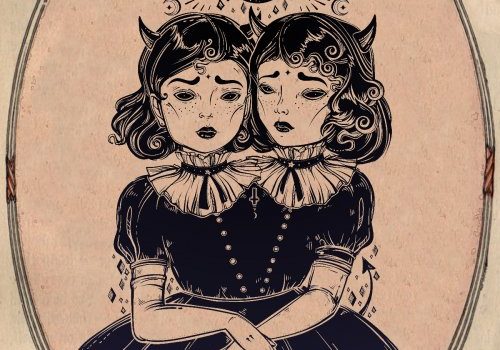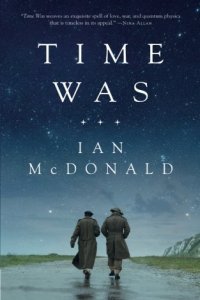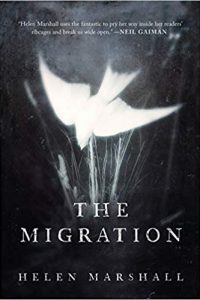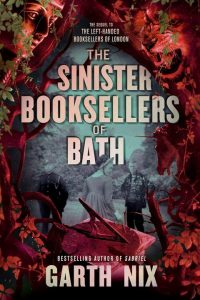Paula Guran Reviews Short Fiction: Nightmare, Black Static, Shimmer, The Dark, and Uncanny
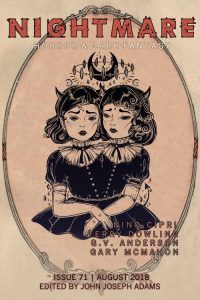 Nightmare 8/18, 9/18
Nightmare 8/18, 9/18
Black Static 7-8/18
Shimmer 7/18
The Dark 8/18, 9/18
Uncanny 7-8/18
Nightmare #71 (August) has two strong original stories. In “Dead Air” by Nino Cipri, Nita is recording interviews with the people she sleeps with: ethnography, sociologically-influenced art. No, it’s not a good idea, especially when she meets Maddie, who is more than just another lover passing in the night. Maddie has secrets. She has long, ropey scars that rake across her back. The town she claims she is from doesn’t exist. Fascinated, Nita can’t help but investigate, but the more she learns the weirder things get. Told in the form of a recording transcript, this little drama is far more complex than you might expect. Cipri never exactly reveals all, but just enough to be effective and scary.
The Crook’s Landing of “Crook’s Landing, by Scaffold” by G. V. Anderson is where “the street grifter, the slick confidence man, and everyone in between” wind up when they die. Usually those who land there forget everything from life, but the narrator remembers his younger brother, Charlie, who was hung two days before him, and seeks him out. This is seen as a sign of great fraternal love. Great setting and dialogue keep you reading.
In Nightmare #72 (September), M. Rickert selects and arranges less than one thousand words into her story “True Crime“. They present the truth, lies, and clichés used to describe crimes of violence and the actions of women against whom those crimes are committed. The result is strangely poetic and utterly indelible.
Weston Ochse‘s “House of Small Spiders” explains how some houses acquire souls. (It takes blood and death, among other things.) These houses also have small spiders “everywhere, non-obtrusive, and ever watchful… the eyes of the house, watching those who live in it much like a great beast would observe its own fleas.” The houses have secrets, too, and the spiders have certain needs. Ochse devises a creepy tale that I wish stuck to its premise a bit more purely.
Black Static #64 offers seven new stories.
I would have appreciated Phoenix Alexander‘s “Something to Burn” at a much younger age. Stories about the meaning of your life or your self-selected death simply don’t resonate as well when you are old as they do when you are young. No slam on the story, just an admittance that it doesn’t “work” for me. No fault to the author.
A man’s father, four months in the grave, returns in the nicely done “Out of the Blue” by Seán Padraic Birnie. He’s not a rotting corpse or zombie or haunt or hologram or whatever; just a supernatural facsimile of some sort. Lifelike, but not alive, he never speaks or opens his eyes. What does one do? One copes and, in the end, perhaps discovers a reason for the impossible.
Tim Cooke‘s “Asylum” has a lot of well-written spooky atmosphere, but I am not sure anything happens. The scene is set. A young man and his friends investigate a haunted woods and something uncanny happens. The man recalls visiting his grandfather in the asylum as a child. Back to the woods, where something uncanny or at least scary is found. Back to the childhood visit. A year or so after the uncanny events, they return to the woods. The narrator goes off on his own and sees, at a distance, something probably uncanny. The end.
“The Monstrosity in Love” by Tim Cooke is sort of a relationship story. A hip twenty-something and a jaded ancient vampire share a world-weary point of view in which love is the ultimate hypocrisy. The girl, however, does what humans do and goes off to become mundane. The vampire continues. Time passes. What do each of them do? Enjoyable and reflective.
Alana has moved from London to a smaller city in Jack Westlake‘s “The Blockage“. After three months, she finally meets her neighbor, Ben, over a clogged drain. She doesn’t meet his wife, Catherine, but sees her acting rather oddly in her garden at night. When Alana’s cat goes missing, you know Alana is never going to see that cat alive again, but you aren’t sure what’s going to happen with the weird neighbors. In the end, everything except the cat achieves a sort of karmic balance. Quite satisfying.
Simon Avery‘s “We Don’t Go Back” introduces us to Eleanor, who was abused as a child and as a wife. Working for a jeweler in Birmingham’s famed Jewellery Quarter, she becomes a trusted employee. When Eleanor’s ex enters the picture and assaults her yet again, the narrator – her
upstairs neighbor – intervenes. Eleanor decides to steal some diamonds and flee. The trio go to Eleanor’s half-brother, Father Joe Abernathy, a priest with a parish on the Salisbury Plain. Father Joe is not your typical modern priest and it doesn’t turn out well. A good story, but I was disappointed it ended with our narrator going out on an open-ended quest we’ll never know the end of.
Shimmer #44 has four originals.
In “The Passenger” by Emily Lundgren, an adolescent girl’s desire to be with the male object of her affection outweighs common sense and a multitude of texted warnings. It’s a creepy story
We don’t know if the whole world is like this, but the terrain Henni and her father traverse in Kristi DeMeester‘s “Milkteeth” is dead and they are starving. Henni discovers she is the daughter of a mother well suited to this dire new world when she meets Beth-Anne, whose mother taught her a bit more than Henni’s. Ambiguous, but haunting.
Elderly Jonesy, in “Bleeding Through the Shadows” by David Rees-Thomas, runs an old corner grocery in a small Welsh town. It’s a staid but stable life until Idris, a childhood friend, shows up to antagonize him with something that happened 50 years before. What’s past is not ever really past and Jonesy has to deal with guilt and ghosts. A thoughtful, evocative story.
Elizabeth Barrett Browning is not resting in peace in “Rapture” by Meg Elison, but she enjoys being awakened. The afterlife isn’t what she expected. Instead, she’s in a place with other deceased authors and each of them awakens only when someone reads their work. This is a quietly compelling tale about the immortality of ink.
The Dark #39 features two worthwhile new stories.
The brothers in “The Last Epic Pub Crawl of The Brothers Pennyfeather” by L Chan have inherited a ghosthunting business from their witch mother. The brothers haven’t seen much of each other since what was evidently some sort of “mess” at Holborn Station. The elder, Bob, has left the Work. Still, he agrees to join brother Bill on a pub crawl. The pubs are, of course, haunted, but the story is really about life, death, and family. Subtly done, with wonderful characterization, this one’s a small gem.
It is a time of displacement in Steve Rasnic Tem‘s “For All His Eyes Can See“. Nothing and no one is stable; anything or anyone might disappear at any moment. Peter can see things others can’t. This makes him valuable to Clarice, but she’s also dangerous. Despite warnings, Peter continues as he has. Tem captures the ambivalent reality and the desperate situation of this world so well you can’t help but shudder. Nor can you avoid the knowledge that Peter is ignoring sure doom. The story stresses and stretches your nerves deliciously.
The two originals in The Dark #40 are not as strong.
In Eliza Victoria‘s “A Prayer to the Many-Eyed Mother“, Ruby has left the Philippines to live with an aunt in the US and find employment, but nothing has turned up. She asks Luciana, a distant relative who is a witch, for help. Her friends, Alejandra and Ava, agree to help. The ritual Luciana asks them to perform is far too much to ask of the young women. Or is it? The writing here could use some improvement, but the idea, dark humor, and emotions conveyed are interesting enough to keep reading.
“Maria’s Children” by Tobi Ogundiran has 15-year-old Muktar finding a rotting chest in the Atlantic near his home in a Nigerian fishing village. It contains real treasure. The next day all the fish in the bay die. Segun, Muktar’s younger brother and the story’s narrator, suspects the treasure is the cause. The story doesn’t quite hang together and a matter-of-fact virgin sacrifice to appease the gods isn’t something you particularly want to read these days, but like Victoria’s tale, it is interesting.
I was hoping for more from the nine stories of Uncanny Magazine #23’s “Dinosaur Special Shared World Issue!” The shared world set out is not really adhered to and the stories aren’t all up to snuff.
My two favorites were “The Tale of the Three Beautiful Raptor Sisters, and the Prince Who Was Made of Meat” by Brooke Bolander and “Red Lizard Brigade” by Sam J. Miller. Bolander dispenses with pseudo-science completely and offers a delightful darkish dino fairy tale. Miller’s tale takes place during an alternate Cold War era. The Soviets secretly discovered gates that can take them to different times and places. They are weaponizing dinosaurs to use against the West. One soldier is suspected of treason and his lover (the narrator) must confront ideas of love, freedom, and loyalty in this powerful story.
In “You Can Make a Dinosaur, but You Can’t Help Me” by K.M. Szpara, Emerick is a trans man. His father, Collier Owen, is the head of The Owen Corporation, an American company breeding dinosaurs. Dad hasn’t accepted that his daughter is now his son and they are estranged. In need of phalloplasty he can’t afford, Emerick and his partner Leo go to Owens Island in hope of patching things up enough to get medical financing. Dad is as blind as ever to his son, but Dr. Noelle Hartford – Owen’s top researcher – provides a different viewpoint. A warm story about what “family” really is.
R.K. Kalaw‘s “Bones in the Rock” is about Tenea. Once a raptor, she now has (somehow) traded ten lifetimes to become a modern human. Her single goal is to find the ancient bones of her beloved and to that end she has become a paleontologist at a museum. The Owen Corporation (evidently the portals are not yet found or at least are a secret) obtains (via huge grant) full access to the museum’s dinosaur bones. Will Tenea’s obsession be thwarted? Will megabucks bring back her long-lost love? As with the previous story, this is not about dinosaurs. If you can ignore the anthropomorphism, the story is effective.
“By Claw, By Hand, By Silent Speech” by Elsa Sjunneson-Henry & A. Merc Rustad concerns Ellery, a deaf paleontologist hired by The Owen Corporation to discover how to communicate with dinosaurs. He attempts to communicate with a velociraptor using sign language. We learn about communication, belonging, and isolation. Again, there are “scientific” assumptions that don’t ring true and that must be overlooked to enjoy the story.
“Everything Under Heaven” by Anya Ow is a charming story, but I’m not sure how it fits in the shared world. Geok Kee is a chef who want to cook a dragon. Sarnai is a huntress tracking a particular dragon to the Dragon Gate on Kuanyin Mountain. They travel together and discuss their upbringings and kill a couple of small dragons. Eventually they find the dragon Sarnai seeks.
The other three stories leave a reviewer with little to say. All are readable but not stellar.
Paula Guran has edited more than 40 science fiction, fantasy, and horror anthologies and more than 50 novels and collections featuring the same. She’s reviewed and written articles for dozens of publications. She lives in Akron, Ohio, near enough to her grandchildren to frequently be indulgent.
This review and more like it in the October 2018 issue of Locus.
 While you are here, please take a moment to support Locus with a one-time or recurring donation. We rely on reader donations to keep the magazine and site going, and would like to keep the site paywall free, but WE NEED YOUR FINANCIAL SUPPORT to continue quality coverage of the science fiction and fantasy field.
While you are here, please take a moment to support Locus with a one-time or recurring donation. We rely on reader donations to keep the magazine and site going, and would like to keep the site paywall free, but WE NEED YOUR FINANCIAL SUPPORT to continue quality coverage of the science fiction and fantasy field.


